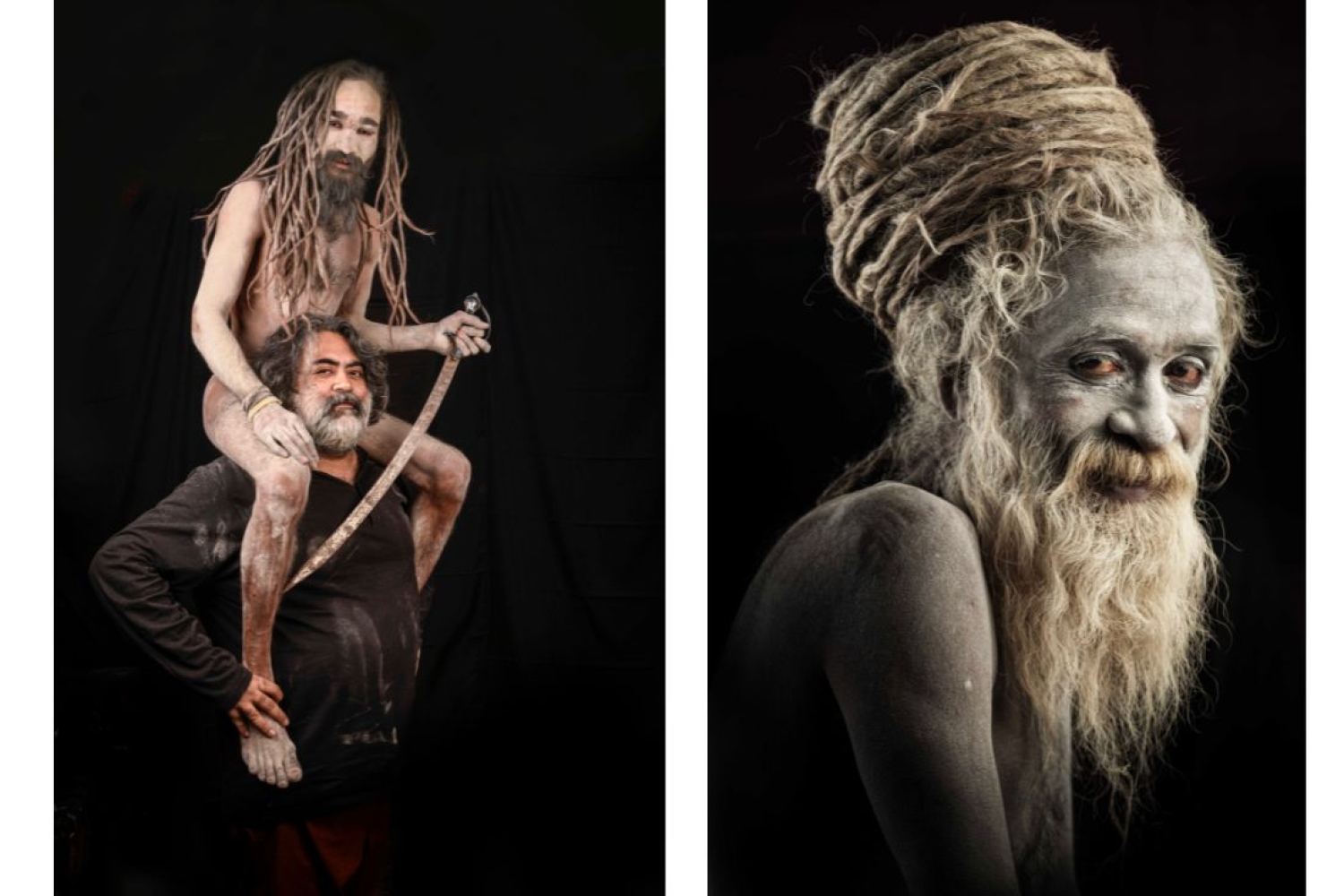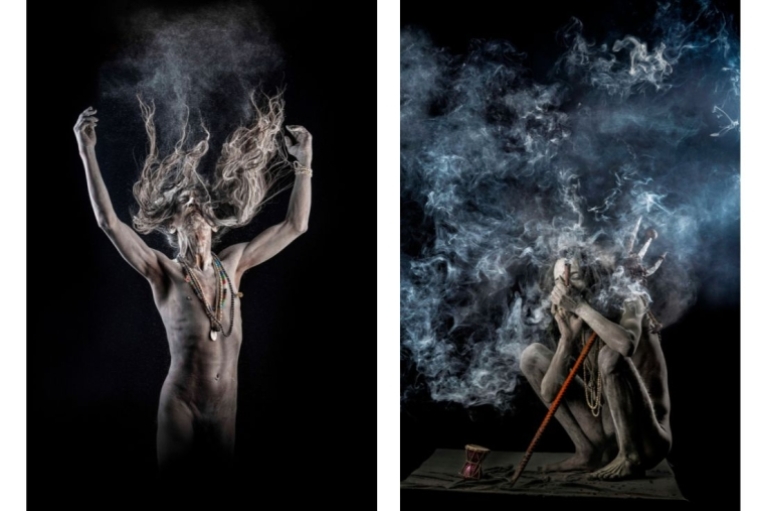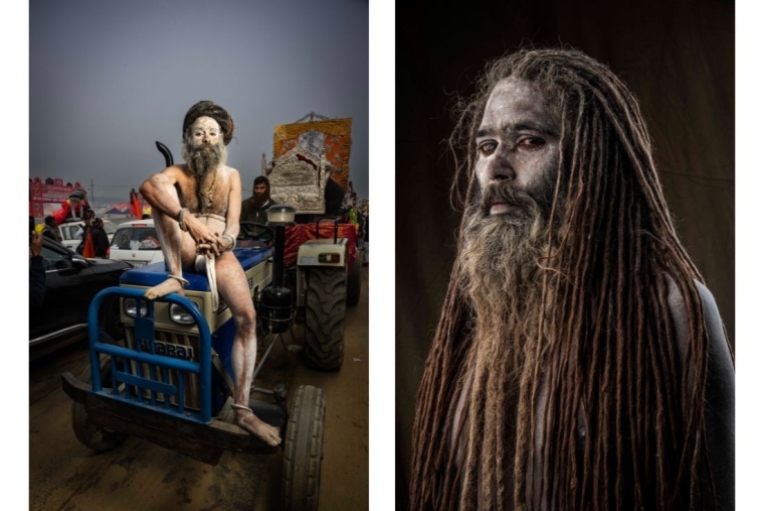

Bandeep Singh presents BHASMANG: The Way of The Naga Sadhus, a series of photographs of Naga Sadhus, photographed at the Kumbh Melas of 2019 and 2025. The exhibition will be held at Travancore Palace, Kasturba Gandhi Marg, New Delhi, with its opening on 24th February 2025 and public viewing from 25th February to 2nd March 2025.
Every twelve years, the Maha Kumbh Mela emerges as a powerful vortex of humanity at the sacred Sangam in Prayag Raj. Millions are immersed in ancient traditions, seeking spiritual renewal. In the colour-soaked chaos, few figures capture the imagination as profoundly as the Naga Sadhus. Draped in Bhasma (ash) with their naked bodies exposed as a canvas of ritual devotion - these ascetics appear as both mystical and surreal. They represent an ancient commitment to renunciation and enlightenment, their lives a vivid testament to the quest for liberation from worldly ties.
Despite being the most photographed subjects at the Kumbh Mela, the Naga Sadhus remain intensely reclusive, often dismissing curiosity with brusque indifference. Their visual representation in media is striking, but largely limited to images of ‘boisterous ascetics’ in processions or dipping in the holy rivers during the ritualistic baths. However, beyond these dramatic depictions lies a deeper, more enigmatic existence that can only be uncovered through intimate observations very few outsiders have had the privilege of attaining. At the heart of this narrative lies an intricate relationship between the photographer and the ascetic. What starts as a pursuit of visual storytelling evolves into something far deeper—a meditation on faith, identity, and the subtle power dynamics between observer and observed. While the Naga Sadhu severs ties with the material world, embracing detachment and devotion, the photographer remains tethered to technology and artistic intent, seeking to capture both the fleeting and the eternal. This duality is what makes their interaction so compelling. How does one who has renounced all attachments respond to being turned into an image—a subject frozen in time? And how does the photographer, driven by his art, forge an unspoken connection with a way of life so radically different from his own? These questions are the foundation of this exhibition, weaving together personal encounters with larger existential musings on the nature of representation, perception, and truth.

On his Relationship with the Naga Sadhus
I have a predisposition to spiritual seeking, Like a magnet I am drawn towards anything that seeks to unite with the infinite. This was my natural gradient when I first visited the Kumbh Mela in 2013, I was completely captivated by the ‘Naga Sadhus’. They are, without a doubt, the true denizens of the Kumbh and express its essence and its spirit. Seeing them felt like witnessing something otherworldly. I was fascinated as I am with images of Naga and Maasai warriors in Kenya. The Naga Sadhus, in their own way, are spiritual warriors.I was drawn to the deeply magnetic presence of ‘Naga Sadhus’—their ash-covered bodies, their unkempt yet effortless detachment from societal norms, and their complete disregard for conventions of politeness or the trappings of being civil. At their core, they exude a profound simplicity, an unfiltered joy. Nudity, for them, is not exhibitionism, or an act of rebellion, but a natural state—the nakedness is worn as a garment. It was all incredibly compelling... and as I observed them, I found myself unable to look away.
In 2019, I got the rare opportunity to go beyond mere observation as I was invited to stay inside the Juna Akhara and document the Naga Sadhus from within their world. Going inside the tent is like a fence you otherwise cannot cross. It is like crossing a borderline. It was a chance to witness their reclusive lives up close—something I had only imagined before. I jumped at the opportunity, knowing it would change everything. And it did.
I spent about 15 days there, with 10 days dedicated solely to shooting inside the tents. In photography terms, 10 full days of shooting is an immense amount of time. But it wasn’t just about capturing images; it was about immersing myself in their world. I spent time interacting with them, talking, sitting around together at the Dhunas, and fire pits, and experiencing them smoking their chillums. It felt like stepping into a subculture, one with its own rhythm, customs, and ways of being. Becoming part of that world, even briefly, was fascinating.
The images that emerged were born from that shared space—moments where the ice between us had melted, where the Naga Sadhus became accustomed to my presence, and I, to theirs. The initial barriers dissolved, allowing for a more intimate and authentic portrayal. It felt almost like photographing them in a lab environment, where I could observe them from every angle—not just their physical presence, but their psyche, their distinct personalities, their body language, their movements, their rhythms.
Such access is rare; they don’t typically allow outsiders to see them so closely, let alone document them in this way.

On Bhasmang
Bhasmang in Sanskrit implies the limbs covered with Bhasma, ash. It is also one of the names for Shiva. The central element that defines a Naga Sadhus from any other Sadhu is the white ash that they cover themselves with, it is called Bhasma or Bhabhoot Wearing Bhasma for a Naga Sadhu is not just an act of ritual adornment. It is deeply spiritual. At the time of Initiation into the Naga fold, each ascetic has 5 gurus, one of whom is the Bhasma Guru – the one who first gives them the secret diksha of wearing the Bhasma. My visit to Kumbh in 2025 was focused more on conversations than photography. I wanted to touch upon the deeper essence of the Naga Sadhu. That is why I feel this work is significant right now rather than at any other point of time, as there is a certain receptivity about the Naga sadhu because of the Kumbh.
Technology, Social Media, and the Changing Lens of the Kumbh Mela
From 2019, things had already changed drastically. Between 2013 and 2019, the mobile phone boom had taken place. The phone cameras became far more sophisticated, and as a result, the Naga Sadhus became a far more prominent subject in the public domain. Between 2019 and 2025, the next shift occurred—the megapixel boom. This explosion in camera technology made high-quality photography more accessible than ever, leading to an even greater influx of images of the Naga Sadhus.
With this, a new category of people emerged: content creators and "reelers." Unlike photographers who come from a practice of reportage and social documentation, many of them have little understanding or respect for the Naga Sadhus. Instead, they contribute to a wave of half-baked, viral misinformation—content that misrepresents the Sadhus entirely. This content, which has flooded social media during this Kumbh, does not reveal anything new or meaningful about them. Instead, it reduces them to a spectacle, distorting their image in ways that are misleading and, frankly, problematic.
Rather than fostering deeper exploration and understanding, this wave of content has largely remained superficial. The Naga Sadhus, once open to being photographed by those who approached them with respect, have now become wary—rightfully so.
Instead of genuine seekers or curious observers, they are now confronted by people who barge into their personal space just for a selfie. This kind of intrusion was very rare before, but today, it has become disturbingly common and the new normal. As a result, the Naga Sadhus are more agitated at being photographed like this. We see increased instances of them reacting with anger—hurling abuses, even resorting to physical attacks—because they are being disrespected, treated not as spiritual ascetics but as props for viral content. People no longer come seeking blessings or meaningful exchanges; they come armed with cameras, asking shallow, thoughtless questions, reducing the sacred to a mere backdrop for their social media feeds. And that, to me, is deeply troubling.
Words Platform Desk
Date 24.02.2025